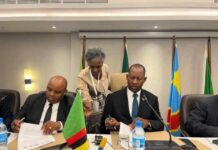The once-thriving Jewish community of Zambia – formerly North Rhodesia – is now down to about 30 members, mostly elderly, with no synagogue and no community center.
Once home to nearly 1,200 Jews, what is left of the Jewish community in Zambia is now scattered in three different cities, with only the skeleton of a communal body to unify them.
That body, however, still has some kick left. Veteran Jewish affairs reporter Yitzchak Hildesheimer reports that the directorate of the Jewish community recently sold five former synagogues, plus the official “Rabbi’s Residence” – and donated the sum of $2 million-plus that it received towards public health projects. Part of the money is going towards renovating the School of Public Health in Tel Aviv University, and part will fund a similar institution in a northern Zambia university.
The Jewish leaders made sure to arrange that the two universities would sign an agreement for academic cooperation between them, including as exchanges of students studying public health.
The remainder of the proceeds from the sale of the buildings has been placed in a special account for the maintenance of the Jewish cemeteries in Zambia.
At a special ceremony at Tel Aviv University to mark the onset of Israeli-Zambian academic cooperation, Michael Galaun, Chairperson of the Council for Zambia Jewry, praised the development, saying it would lead to stronger ties between the two countries. Zambia established its embassy in Israel in 1992.
Galaun noted that the Jewish community in Zambia produced a local government minister, as well as Members of Parliament, judges and other notable figures. Arguably the most notable Jewish figure hailing from Zambia was Stanley Fischer, the former Governor of the Bank of Israel and today the Vice Chair of the U.S. Federal Reserve System.
Also in attendance at the ceremony was Rabbi Moshe Silberhaft, “the Travelling Rabbi” for the Jewish communities across Southern Africa.
The Zambian Jewish population began in the early 1900’s when many Jews arrived and engaged in the cattle production and copper-mining industries. Jewish refugees came to Zambia both before and after the Holocaust, with the population peaking in the mid-1950s. Then began the decline, and by 1968, only 600 Jews remained.
SOURCE : israelnationalnews.com

 JOIN DRIVERN TAXI AS PARTNER DRIVER TODAY!
JOIN DRIVERN TAXI AS PARTNER DRIVER TODAY!











